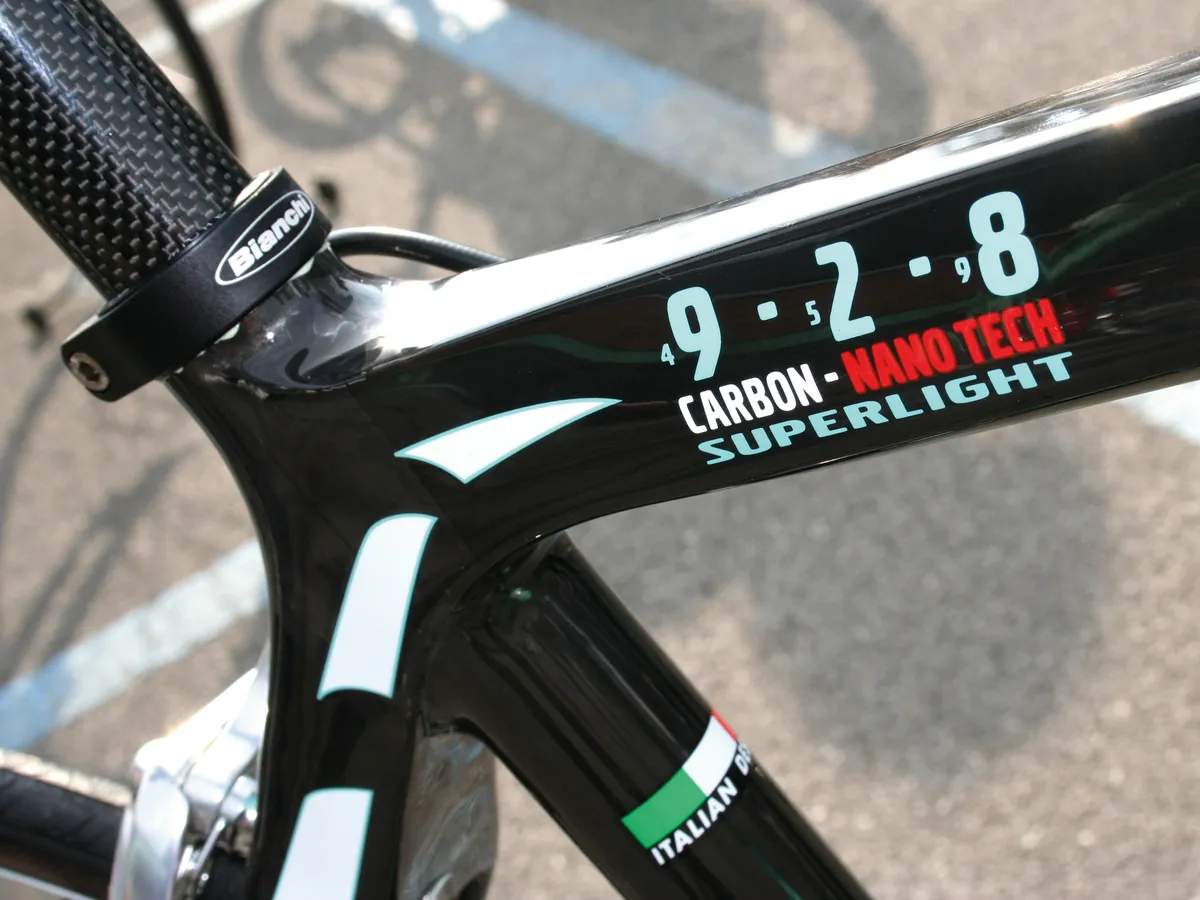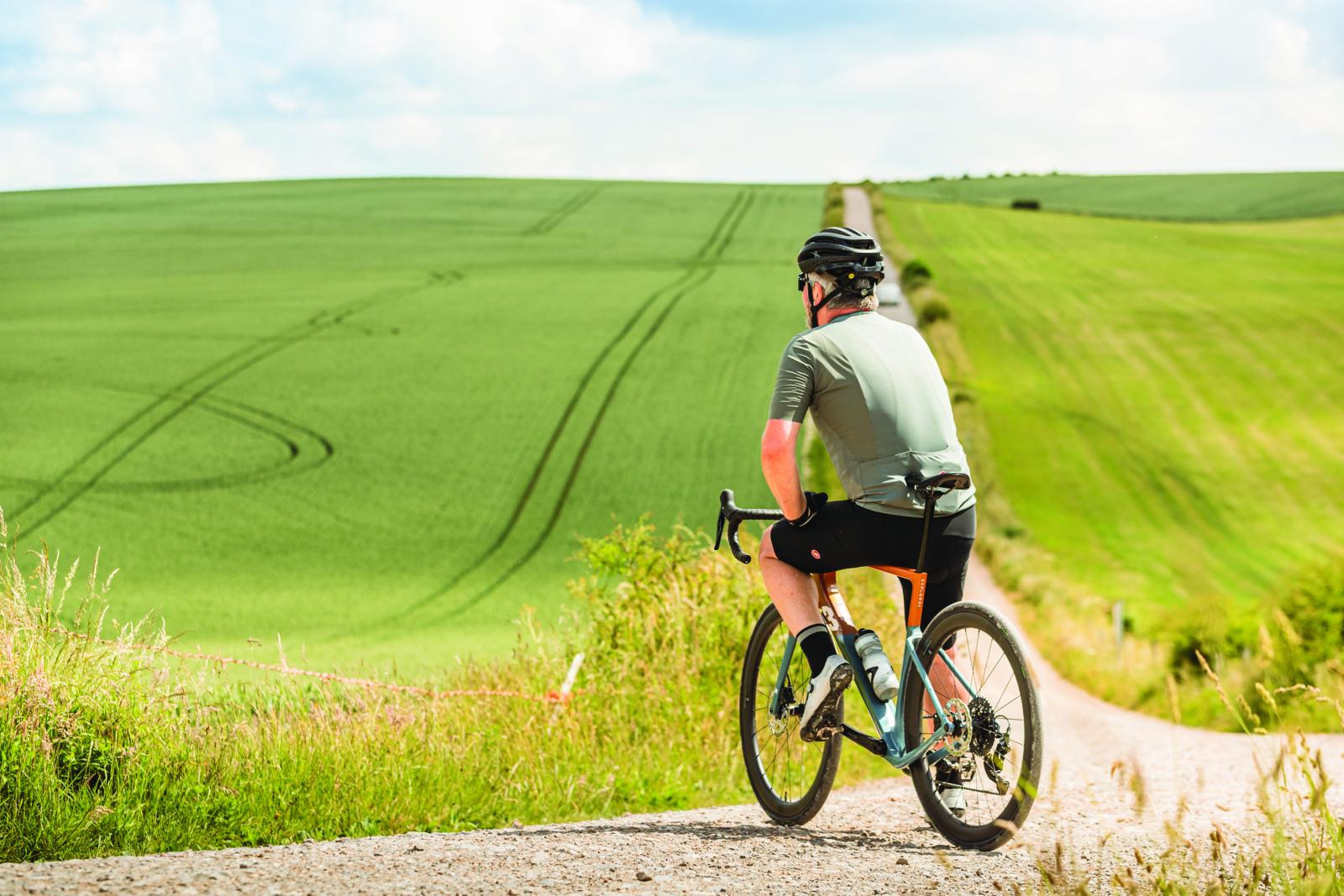Race bred geometry combined with light carbon make Bianchi's HoC 928 series the cream of their current crop. The HoC Carbon 928 SL UD now sits atop the composite bikes range, with an all-new, high modulus, uni-directional carbon monocoque frame design
Frame
The carbon itself is of the nano-tech variety (similar to Easton and BMC - see our Le Tour supplement with this issue) and is exclusive to the Italian giants. The frame, compared with previous HoCs, has resculpted, low weight dropouts and a new oversized bottom bracket shell to improve stiffness throughout the transmission. The frameset's tubing is reworked with a triangulated top-tube which flows into a more ovalised box section at the seat-tube. This then flows through into the seatstays - as with Wilier's Cento and Specialized's Tarmac. The down-tube starts in a more conventional round section but increases in diameter and ovalises at the reworked B/b area.
All these design tweaks combined with the new material (along with the dropping of the 12k weave outer layer of previous incarnations) have given the 928 SL UD a very competitive weight of just 900g (for the 55cm model), and in conjunction with a new 300g SL fork, this is a seriously lightweight chassis.
The test bike I rode in the Bergamo hills (specced with Campag's Chorus and Zonda wheels) came in at a complete weight of a touch over 7kg/15.4lb - light enough in anyone's book - and remember, this is no superbike component spec, more what most of us would use day to day.
Handling
Aboard the 928 the first thing you notice is the weight: this is one light bike. Climbing on the 928 it felt nimble and quick, and out-of-the-saddle stomps up steep sections were remarkably free of any stresses - no wandering, no flex, just forward motion. In other words, the lateral stiffness of this bike is among the best I've tried. Once the climbs had been conquered, descending felt planted, and in out-of-the-saddle sprints quick direction changes were instant and without drama.
I had no expectations of comfort because bikes of this ilk are usually all about efficient transmission of power, and can lead to a rather harsh and eyeball shaking ride over rough surfaces, so I was pleasantly surprised at the comfort level of the SL. It's not quite in the league of a titanium bike or, for that matter, a Time VXR, but it's certainly much better over harsher surfaces than most of the US bikes I've tried and those from the other big Italian marques.
Equipment
There is a no-nonsense aspect to the spec of the HoC and that, to me, is a good thing. A complete Campag Chorus groupset (with the stunning Carbon Ultra Torque chainset) performed flawlessly, as expected. Shifts are crisp and quick, and the ability to flash from top to bottom at the summit of an ascent - before the inevitable descent - is one of this tester's favourite feelings.
The rest of the bike is built with top flight equipment from Italy. The FSA carbon headset looks suitably bling and, having the very same on my own carbon hardtail Mtb, I can vouch for its longevity. Deda's Campione bar has a fantastic traditional bend and slightly oversized diameter at the grips - great if, like me, you have shovel-sized hands - though, at just 42cm wide, I would have preferred them wider. The bars are combined with Deda's Forza carbon stem, which is not a component I've tried before, but I'm glad I did. It's stiff, even when out of the saddle, and honking the bars there was no noticeable flex or undue noises. An old favourite is Deda's classic Carbon Magic Stick seatpost, and it didn't slip in the frame (which is common on carbon post/carbon frames) of this well set up bike.
Selle San Marco's Aspide Ti (in co-ordinated celeste, of course) topped the post, and this slimline and svelte race saddle was surprisingly comfortable. It's fast becoming a favourite of mine after the ubiquitous Fizik Arione.
Wheels
Campagnolo's Zonda sits midway through the medium profile range of Campag's wheels. If you're familiar with Mavic, this is the Ksyrium Elite equivalent. It's tough and good looking, noticeably stiff when riding but it's no lightweight race hoop - at 1,610g a pair we're talking more middle than flyweight, but it's solid and dependable and would easily see you through a few seasons' riding.
Continental's 4 Season GP is again a good, solid product. It's not a super light race slick; as the name suggests, this is a year round ride. It gripped superbly in descents, felt supple over the rough stuff but never felt quick - great for the training bike but a machine with the calibre of the HoC deserves something with a little more go. I'd love to try the HoC with my own handbuilt, lightweight wheels shod with the superb Schwalbe Ultremo clinchers to see just how much more this chassis would give.
The advances made from last generation composite bikes to this, the latest top flight HoC, are massive. What Bianchi have created and given us here is a bike that's light enough for anyone, tough enough to take the knocks and with a quality of ride that simply blew me away. It's usual to find a modern pro level bike that offers this level of tractabilty and directness combined with impeccable power transfer, but this is all wrapped up in the one thing we all need, and that's comfort. Vibration damping through the UD SL frame and fork is simply astonishing for this type of bike, and I for one can't wait until we can get the full production model into the pages of Cycling Plus for an extensive road test.





